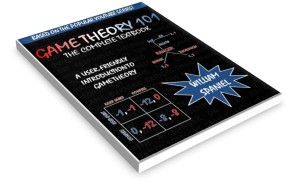The last lecture featured an example game with a simple Bayesian Nash equilibrium. Not all games will be that easy to solve. This lecture introduces a brute force technique for those cases. With some careful calculations, we can convert an incomplete information game to a single matrix that captures all types’ moves, and then use the standard Nash equilibrium algorithms to solve for the Bayesian Nash equilibria.
Takeaway Points
- To convert a player’s various types into a single set of strategies for the player, we first must define the strategy combinations for the various types. For example, suppose a player had two types and each had two pure strategies: left and right. Then there would be four pure strategies for the player overall: LL, LR, RL, RR. The first letter indicates the strategy that one type plays, while the second letter indicates the strategy that the other type plays.
- To fill in the payoffs for each matrix of the new game, multiply each type’s payoffs by the relative probability of each type and sum them together. This step can be the hardest to do properly: it is tedious and any wrong calculation can invalidate the equilibrium conclusions drawn later.
- Once the matrix is completed, you can solve for the Bayesian Nash equilibria by the standard methods to solve for Nash equilibria. For example, marking best responses will generate all the pure strategy Bayesian Nash equilibria. The mixed strategy algorithm will also work as before.
- The conversion process will preserve any dominance relationships. Thus, you do not have to do any pre-conversion manipulation to obtain the correct answers. It also means that you can use iterated elimination of strictly dominated strategies on the matrix.
- A mixed strategy Nash equilibrium in the subgame does mean that all types mix in the Bayesian Nash equilibrium. For example, suppose the aforementioned player mixes between RL with probability 5/8 and RR with probability 3/8. Then the first type plays right as a pure strategy. Only the second type truly mixes, choosing left with probability 5/8 and right with probability 3/8.
- If the types of a player in equilibrium choose different strategies, even just different pure strategies, then it will appear to the other player that they mixing. This has a deeper connection to how we can interpret mixed strategies from complete information games, which we will return to later in this unit.

